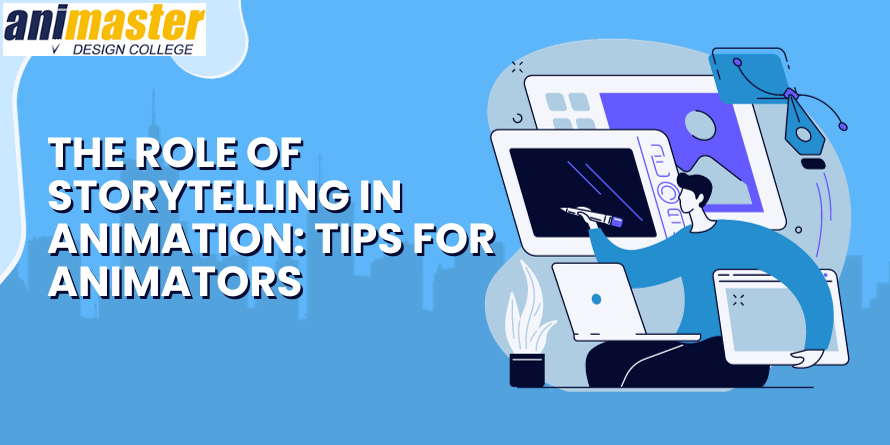
The Role of Storytelling in Animation: Tips for Animators
The enchantment of animation crosses age, cultural, as well as linguistic boundaries. The importance of storytelling in animation cannot be stressed because it is at the heart of animation. The core of outstanding cartoons is effective storytelling, which attracts viewers into carefully developed worlds and elicits emotions, that leave an impression that lasts.
In this guide, we’ll analyze the most important component that storytelling plays in animation as well as offer insightful advice that’s designed to assist animators in becoming masters in their craft.
Role of Storytelling in Animation
- Conveying Emotion and Connection
Watching a cartoon with unreal or unrelatable characters comes to mind. That wouldn’t make for very good entertainment, would it? As a result, animated characters feel more lifelike thanks to an outstanding narrative. Giving them personalities and feelings that we belong to is like attempting that. We are able to connect to the characters’ laughter, tears, as well as fright. It forges a connection between us and the animated world, and that is the power of good narrative.
- Building Engaging Characters
Your favorite animated character comes to mind. Exactly what distinguishes them? It probably stems from their personality, peculiarities, and difficulties. These characters are given life by animators with the aid of stories.
They transcend the realm of mere illustrations and become our closest companions or favorite characters. Like a great book with communicating characters, excellent storytelling in animation gives characters depth whilst rendering them interesting.
- Developing Engaging Plots
Think about a puzzle that is incomplete. The animation would end up being like that unfinished puzzle without a narrative. The thing that keeps everything together is a good story. It’s what keeps us interested from start to finish. Plots provide excitement to animation, whether it’s a thrilling adventure or a straightforward, everyday tale. They want us to stick around to see what happens next.
- Visual Storytelling
Words alone aren’t always sufficient to describe a narrative. Visual storytelling can help with that. Animation demonstrates concepts using visuals rather than words. Similar to a secret language, each image conveys a lot of information.
In visual storytelling, movements, colors, and camera angles are all important. It’s like a secret code that gives the animation additional layers of significance.
- World Building and Atmosphere
When you view an animation, visualize entering a brand-new universe. The outcome of world construction through storytelling is that. It’s not simply characters that animators create, they additionally build entire worlds with their own culture and ambiance.
It feels as though you have been taken to another world. It doesn’t matter if it’s a bright beach or a terrifying haunted house, the environment creates the mood thereby rendering the animation seem realistic.
- Message and Theme
A deeper message, such as a lesson or notion they intend to impart, is frequently hidden behind animations. In order to communicate messages and themes, storytelling is helpful. It resembles undiscovered gold that is just waiting to be found. The narrative aids in conveying the message without coming off as prescriptive, whether it is about friendship, bravery, or environmental preservation.
- Evoking Imagination
Do you recall how distracted you felt watching animations? Storytelling in graphic designing at its best, there. Your imagination is given a spark, so to speak. The space provided by animations allows for unrestricted cognition.
You ponder and marvel at the world they have contributed to as a result of them. The appeal of good storytelling is that it occasionally leaves things out, allowing you to fill in the blanks with your own interpretations.
- Storytelling Across Genres
Animations can be humorous cartoons or grandiose journeys. They come in many kinds and sizes. The thing that unites them all is storytelling, though. They all have a delightful hidden ingredient, sort of. The art of storytelling in animation can be adapted to match various genres, whether it’s a ridiculous comedy or an exciting mystery. It morphs hues to fit the situation, much like a chameleon.
Steps for Mastering Storytelling in Animation
- Understand Your Characters
Any animation’s characters are its lifeblood. You need to have knowledge of them inside and out in order to bring them to life. Consider your characters to be close friends, each with their own characteristics, drives, as well as foibles.
Why do they do it? What do they hope for and fear? Your characters will become more relatable and interesting for your viewers as a result of this comprehension. Spend some time establishing the backstories as well as personality traits of your characters because they are likely to assist readers in remembering them.
- Focus on the Story Structure
A solid scaffold is what a well-structured story is to your animation. Adopt time-tested narrative frameworks, such as the traditional three-act structure (setup, conflict, resolve). Introduce your world and people in a strong opening paragraph.
In the second act, intensify the suspense as well as excitement, and in the third act, offer a satisfactory resolution. Your story will continue to unfold naturally and continue to keep the audience interested from beginning to end if it has a strong framework.
- Pay Attention to Pacing
The pace of your animation is its narrative beat. It acts as a kind of musical beat to lead your listeners through the story. Action, humor, and emotional moments are all balanced in a well-paced animation.
Think about how scenes are paced; slow them down to create tension or ratchet them up for an adrenaline rush. Pacing well might help you manage the emotional rollercoaster that your audience will go through while watching your animation.
- Use Symbolism and Metaphors
The use of symbols and metaphors by animators to add depth to their stories is similar to how artists use color as well as brushstrokes to convey deeper meanings. Using tangible items or components to depict immaterial concepts or themes is known as symbolism.
When using metaphors, the known and unknown are compared. In order to encourage viewers to look beyond the surface of your animation, include these components. It’s similar to including secret Easter eggs that, after several viewings, can increase the enjoyment of your animation.
- Show, Don’t Tell
Because animation is a visual form of narrative, it works best when you “show” rather than “tell” what is happening. Let the characters’ actions, reactions, and surroundings disclose the story’s subtleties rather than having them constantly explain everything through dialogue.
For example, a character’s body language can portray fear, enthusiasm, or determination more effectively than their words. The more you trust your audience with understanding these visual signals, regardless of how immersive as well as powerful your tale will be.
- Seek Feedback
Collect feedback from others, and stay away from working alone. With classmates, mentors, or participants in focus groups, present your animation. You are able to enhance what you’re doing by identifying plot gaps through the application of constructive feedback.
Someone else may spot discrepancies, make new suggestions, or provide a different viewpoint on your story. Accept critique as a valuable resource for honing your storytelling abilities.
- Learn From Masters
Study the works of legendary animators to improve your storytelling skills. Analyze animated films and television programs from the past as well as the present. Why are they successful? Pay close attention to their application of storytelling, development of characters, as well as pacing. Finding inspiration as well as concepts from the greats are capable of helping you in improving your own work.
- Experiment and Innovate
Don’t be scared to push the limits of animation narrative. Try out several story stances, approaches, and styles. Making use of the opportunity to develop because animation industry allows for creative freedom. Try exploring novel visual storytelling techniques, original character interactions, or novel plot designs. By bucking the norms, you could find novel ways to engage your audience.
- Learn from Mistakes
The path to mastery is paved with mistakes. Accept them and use them to inform your storytelling journey. When anything in your animation doesn’t work, step back and consider why. Was it the ambiguity of a character’s motivation?
Was there a scene where the pacing lacked tension? Your ability to tell stories is going to improve as a result of learning from your errors and making corrections.
How Animaster Can Help You to Become a Good Storyteller
- Animaster offers well-organized courses that cover the principles of animation as well as storytelling in animation strategies and character development.
- Personalized comments and mentorship will be offered by knowledgeable educators to help you improve your storytelling abilities.
- Animaster, one of the top colleges to pursue BSc Animation in Bangalore links students with professionals in the field, encouraging hands-on learning.
- Access to industry-standard animation software gives you the cutting-edge tools you require to effectively bring your story to life.
- Animaster, one of the best animation college in Bangalore connects you with a network of creatives who share your interests, promoting collaboration as well as idea sharing.
Conclusion
One cannot stress the value of narrative in animation. Every animated piece revolves around it, it is what draws viewers in and makes an everlasting impression. Watch as your animation career soars as an outcome of embracing it, learning it, and ultimately conquering it.



